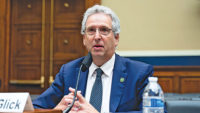President Donald Trump’s barrage of executive orders continued in the second week of his administration as construction industry participants and observers sought to absorb current impacts and future ramifications of new edicts, particularly the much-touted campaign promises for an extended wall on the U.S.-Mexico border, a cutback of the Obama-era push on regulation and new curbs on U.S. entry for immigrants and travelers from some Muslim countries, as well as two promised pipeline projects.
But many details of the administration’s pronouncements remain unclear, especially the scope, timing and financing of ambitious infrastructure plans.
Even so, the Jan. 30 Trump executive order mandating the elimination of two regulations for each new one brought a level of satisfaction to some construction-sector groups that claim firms and projects have struggled to keep up with the compliance load. “The president will decide what to stop, what to continue and what to rewrite,” said Jeffrey Shoaf, senior executive director of government affairs for the Associated General Contractors. “We don’t have a clear path on where he’s going, but we’ll need to be diligent defending the administration … that they identified the problem.”
Reversed Rulemaking
Congress also moved to rescind several Obama regulations under the Congressional Review Act, which provides 60 legislative days to repeal rules through resolution if they were finalized since last June.
The House voted on Feb. 2 to repeal the so-called “blacklisting rule,” which requires all federal contractors bidding on contracts over $500,000 to report collective bargaining, civil rights and safety violations over the past three years. A federal judge issued a preliminary injunction last October to block the labor-supported rule, which had strong contractor group opposition.
Resolutions also have been introduced to roll back a regulation that adds new restrictions to coal development by requiring companies to monitor and test waterway quality in mining operations, as well as a rule that would limit methane emissions from oil and gas operations on federal and tribal lands.
Environmental advocacy group Friends of the Earth claims the Trump regulatory order “disregards the benefits that environmental and worker protections bring to America.” But some observers sought to allay fears that the regulatory changes would undermine the industry’s environmental services sector. Scott Kolbrenner, managing director of the engineering and construction practice at Houlihan Lokey, said the continued demand for those services “is underpinned by the need for growth and sensible regulation.”
Despite national upset, numerous lawsuits and court injunctions, and huge protests at airports where officials had detained immigrants and travelers caught by the surprise Trump order on Jan. 27 banning entry into the U.S. of foreign nationals from seven Muslim countries, a spokesman for AECOM, which has design and construction work in Iraq, said the restriction “has not interrupted operations on our projects.” He said the firm has “provided resources to support those who may be impacted.” ENR data show more than 30 U.S.-based design firms and contractors reporting revenue from work there.
“We do have many students applying from Iran and Iraq every semester. How this is going to change is not yet clear.”
—Hussain Bahia, Engineering professor, U. of Wisconsin-Madison
However, the beginning of the Trump “extreme vetting” plan for refugees and travelers from the targeted nations as its terrorism-prevention step brought strong reaction from numerous chiefs of large technology firms and academics concerned about the impact on future recruiting of students and faculty in engineering and related fields.
The Trump order was “a stunning violation of our deepest American values … in a nation made rich by immigrants, why would we signal to the world that we no longer welcome new talent?” said MIT President L. Rafael Reif, a Venezuelan-born industrial engineer. In a note to Rutgers University students, President Robert Barchi noted an estimated 17,000 international students from the seven nations at U.S. colleges and universities.
“We do have many students applying from Iran and Iraq every semester, some who we have already offered admission to and could be in the process of getting visas,” said Hussain Bahia, a University of Wisconsin-Madison civil engineering professor. “How this is going to change is not yet clear.”
Border Blues
Trump also provided few details on the much-touted border wall, although early pronouncements on extracting payment for it directly from Mexico’s treasury or indirectly through a much-criticized 20% tariff on Mexican-made goods imported to the U.S. forced administration spokesmen to "walk back" the financing plan for now.
While Trump had estimated an $8-billion cost for the wall during the campaign, a report, based on MIT project-cost analysis and published last fall, said the cost could approach $40 billion, even for a barrier that would not extend along the entire 2,000-mile border, based on labor, materials and other costs.
Lee Maril, a sociology professor at East Carolina University, Greenville, N.C., who previously lived along the border and has chronicled the construction and impacts of the current barrier, notes protracted battles over eminent domain in Texas.
"In Nogales, they wanted a wall. But in other other areas, there definitely was resistance," says Maril. He also notes haphazard management of contracting between federal agencies and local governments. “It’s not in public records who was doing what for how much,” says the researcher. "It's very difficult to find records of concrete and steel," he adds, noting that the Border Patrol and Dept. of Homeland Security "don't have a solid contracts acquisition and management system."
A program run by DHS for a high-technology surveillance system along the border, awarded in the Bush Administration to Boeing Corp., was ended in 2011 by a successor admnistration. According to Maril, "Boeing never fulfilled the obligations of the contract."
Maril adds that while the DHS contracting system has improved more recently, "it remains to be seen if they’d be able to handle" the Trump project.
The U.S. has turned to Israel's high-tech sector for technology involvement. Elbit Systems, through its US based subsidiary, is already involved in a security project along the Arizona Mexico border.
Another Israeli high-tech firm, Magal Sytems, also is eyeing the proposed border wall. "It’s a huge project in comparison to what work we carried out in Israel over the years,” says a vice president, Doron Kerbel. He said Magal has been involved in all of Israel's major border security projects, including the 230-km long Israel-Egypt barrier that was set up to deal with a growing problem of migrant workers crossing into Israel from the Egyptian Sinai.
But he noted that terrorism was also a major concern for the project and the smuggling of weapons.
The company has worked on border fences in other countries, reportedly along the border with Pakistan in Kashmir, but Kerbel would not confirm. He says the firm is very interested in the project along the Mexican border, but said that Magal would likely team up with American construction companies through its Senstar wholly owned subsidiary in the US.
But Adds Mark Minter, executive director of the Arizona Builders Alliance: “We tend to not get too worked up until there are requests for proposals. Until then, I don’t think anybody is going to create a border-fence division in their company.”
Show Me the Money
Also still hazy are the parameters of Trump’s extended infrastructure investment program, touted at $1 trillion. A list of “priority projects,” published last month by one newspaper chain, could not be verified in other media reports. A list
With other priorities, such as the repeal of the Affordable Care Act, Shoaf and other industry observers speculate that action on infrastructure and tax reform will be pushed back. The House Transportation and Infrastructure Committee was set to hold an infrastructure hearing this week featuring manufacturing CEOs, but without a bill or plan.
The Trump focus on the use of private funding, tax credits and repatriated foreign profits of U.S. firms to finance projects also lacks detail. "We would like to see infrastructure as the way to invest overseas profits," said AGC's Shoaf.
“The best approach to infrastructure, and the one that produces the greatest public benefit with often-limited funds, is to combine the strengths and resources of the public and private sectors wherever possible,” says Amanda Clack, president of RICS, a global construction professional standards group. “Money must be spent with a long-term view," The UK-based Ernst & Young infrastructure practice chief emphasizes that "the biggest risk to investor appetite and delivery is a lack of certainty.”
Brian Pallasch, managing director of government relations for the American Society of Civil Engineers, added that "there’s certainly an ability for [private finance] to be done and useful. But in some sectors of the federal government, there’s not a good understanding of the process to use P3s.”
And despite Democratic resistance, Trump’s picks for key cabinet posts are mostly moving forward. On Jan. 31, the Senate by a 93-6 vote approved Elaine Chao as transportation secretary and the Senate Energy and Natural Resources Committee submitted for a full Senate vote the nominations of Rick Perry to lead the Dept. of Energy and Ryan Zinke to lead the Dept. of the Interior.
But the Senate Environment and Public Works Committee could not vote on Feb. 1 on Scott Pruitt to lead the Environmental Protection Agency, when Democratic members boycotted the confirmation hearing and said they had not received answers to a lengthy list of additional questions. Two Republicans on the commitee had boycotted the confirmation hearing of previous EPA Administrator Gina McCarthy in 2013.








Post a comment to this article
Report Abusive Comment